Clotted Cream is deliciously creamy and the essential companion to a batch of British scones. You don’t have to go to England to enjoy your tea-time treats though, because it is so easy to make at home!
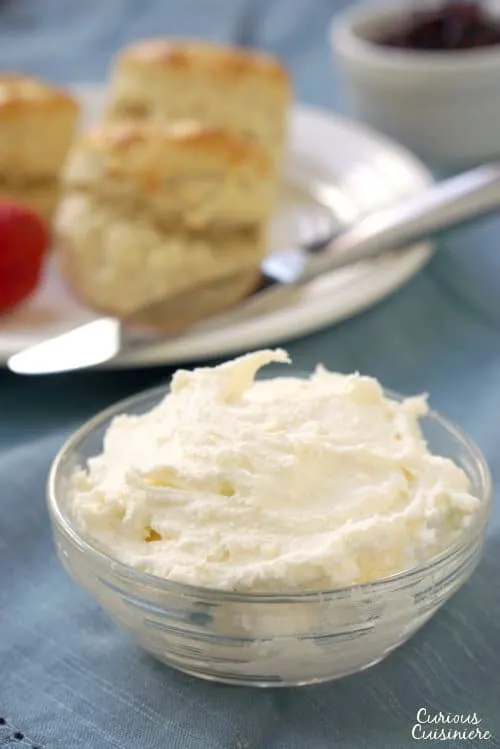
What is clotted cream?
Clotted cream is a staple on British tea-time tables. You’ll find it served in a little dish right alongside your scones (or very traditionally, Cornish ‘splits’, a type of yeast bun).
It is a thick, creamy, white spread, with the consistency of softened cream cheese. It is ever so slightly sweet, but mostly just incredibly creamy. Like a good, unsalted butter.
But so much more.
Devonshire cream vs clotted cream
Sometimes you may hear “clotted cream” called “Devonshire cream” or “Cornish cream”. It really all depends on the region you are in.
The making of clotted cream started in Devon as a way to separate the fat from milk to make butter. Centuries later in Cornwall, it became popular to use the cream on its own. At that time, clotted cream and butter were the most popular ways to preserve milk.
One of our readers sent us a wonderful insight into clotted cream making, that is worth sharing. Angela spent her childhood during WWII at Callington with her grandparents who were retired farmers on the Devon/Cornwall border. She explained that the real difference between clotted cream in Devon and Cornwall came down to the process.
She stated,
“Devon cream was made by putting the full milk straight from the cow into a large enamel pan. It was then rested overnight to allow the fat to rise to the top. Then the pan was placed on the range over a pan of simmering water until the cream became a crust. (The milk must not boil!) It was then removed and allowed to become cold in the pantry – no fridges then.
When cold, the thick crust was carefully scooped off the top of the milk and put in a cream dish ready for use. The remaining fatless milk was used for cooking and on farms, surplus skim milk was used to feed pigs etc.
This was the method we used as we no longer had the farm. Just 2 bottles of unpasteurized full cream milk produced enough cream for splits, stewed fruit or junket.
Cornish clotted cream was made as follows – The full milk was poured through a separator. This was a rather complicated piece of mechanical equipment used on farms to separate the fat from the milk.
The full cream was then put into the enamel pan and very slowly heated on the stove until it thickened from top to bottom. No skimming needed. When cold, it could all be eaten!
This is what can be bought in supermarkets today.”
Many thanks to Angela for sharing her knowledge and family heritage story with us!
Of course, those in Devon and Cornwall each claim that their cream is superior.
I guess we’ll have to take a trip to decide for ourselves!
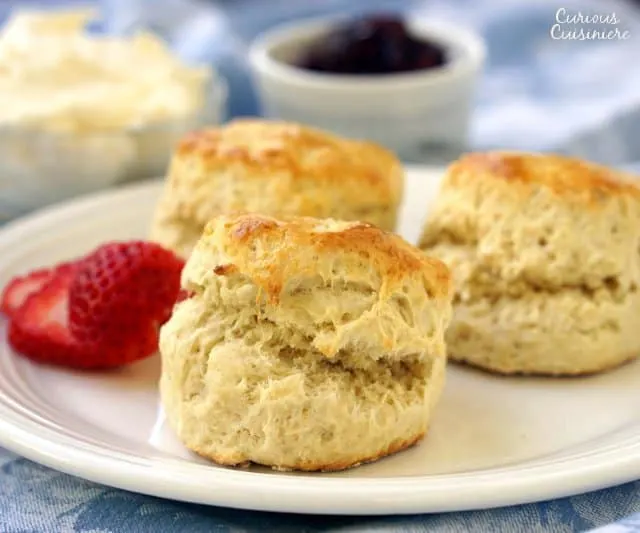
Ingredients
The ingredient list here couldn’t be any shorter. You just need to get yourself some heavy cream.
However, the hardest part about making clotted cream might just be finding the cream.
You see, for best results, you need to start with heavy cream that has not been ultra-pasteurized for a longer shelf life.
Simply look for a carton of heavy cream that does not say “ultra-pasteurized”, and you’re good to go!
Can I use ultra pasteurized cream?
Finding non-ultra-pasteurized cream is becoming more and more difficult in the States, so many of our readers have asked if they can use ultra-pasteurized cream in this recipe.
Luckily, the answer is yes (most of the time). Some of our readers have had luck using ultra-pasteurized cream. However, because of what the ultra-pasteurization process does to the protein and fat molecules in the cream, you will get less clotted cream if you start with ultra-pasteurized cream than if you can find some that isn’t.
How to make clotted cream
Clotted describes the look of the cream when it is heated ever-so-gently so that the fat separates to the top and clings together.
After you find your cream, the second hardest part of making clotted cream is the wait.
This is not a quick process.
The cream has to be heated slowly for 12 hours, which we find easiest to do overnight. Then it is cooled for another 8 hours (or over the next night).
Finally, you separate the cream from the liquid, and you have the spread that you have been waiting for.
It might take a long time, but it’s mostly hands-off.
And it’s SO worth the wait!
Can you make clotted cream in the slow cooker?
This is a question that we get often from our readers, so we did some testing to find out.
The answer is yes you can! Have a look at our recipe and process for making clotted cream in the slow cooker.
There are also some nice tips and tricks about making clotted cream in general over there, so even if you’re thinking about making it using this oven method, take a look over there for the tips!
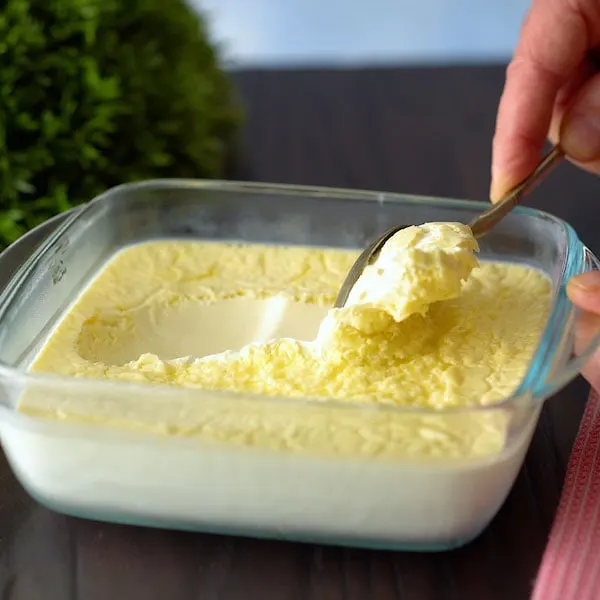
How to store the finished product
You will want to store your clotted cream in an airtight container in your refrigerator. For best storage, store it a place in your fridge that stays a consistent, cool temperature – so not in the door. Closer to the middle is where we like to keep it.
How long does homemade clotted cream last?
Your homemade clotted cream will stay fresh for about 3-4 days if properly stored in the refrigerator. After that, it may start to lose its consistency.
However, if you happen to let your clotted cream get just a bit past its prime and the texture just isn’t quite right you can always use it to make fudge or ice cream.
How to use clotted cream
The traditional use for clotted cream is on scones, with jam, served with tea.
However, if you find yourself with an excess of clotted cream and no scones, you can always serve it with Irish soda bread, muffins, apple pie, a fruit tart, or any dessert or sweet bread of your choosing. It also makes a nice fruit topping.
Basically, you can use it any way you would typically use whipped cream or butter.
Savory uses for clotted cream
Clotted cream typically lends itself to sweeter uses: spread on scones (or “splits” as Angela pointed out to us were more common where she was growing up) with some jam.
However, it is rich and creamy and you can use it for savory applications as well.
We think it would be delicious as a veggie dip or spread on a cucumber slice as an appetizer.
You could also add it to mashed potatoes, risotto, or eggs to give them extra creaminess, much like you would butter. Or you could add it to soups or sauces to give them a creamy boost.
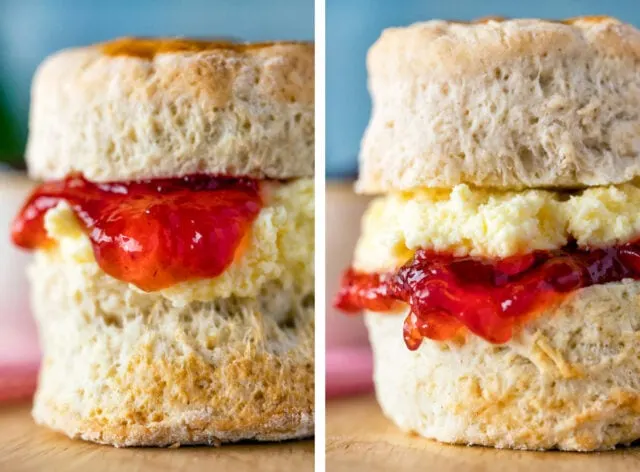
What’s the difference between clotted cream and whipped cream?
While at first, a bowl of clotted cream might look similar to whipped cream. But once you take a taste, you’ll know the difference.
Both start with the same basic ingredient: heavy cream. But, for whipped cream, you whip that cream into light and fluffy pillows. Often you’ll add sweetener and possibly a flavoring, like vanilla, to whipped cream as well.
Clotted cream, on the other hand, is heated and separated, as we’ll go into more detail below. This process produces a thicker, creamy substance.
Another difference is that clotted cream is typically not sweetened. People love it for the creamy texture it adds, similar to butter, rather than a particular sweetness or flavor.
What’s the difference between clotted cream and butter?
So, if it has a thicker consistency and is more savory, how is clotted cream different from butter?
Again, it comes down to the process.
Butter is made by churning (or whipping) cream. So, if you over-whip your whipped cream, you’ll end up with nice, whipped butter.
Clotted cream, again, has to do with the separation of the fat in your cream.
Our reader Angela pointed out to us that the making of butter in a churn took additional time and hard work. So making clotted cream was a much easier option.
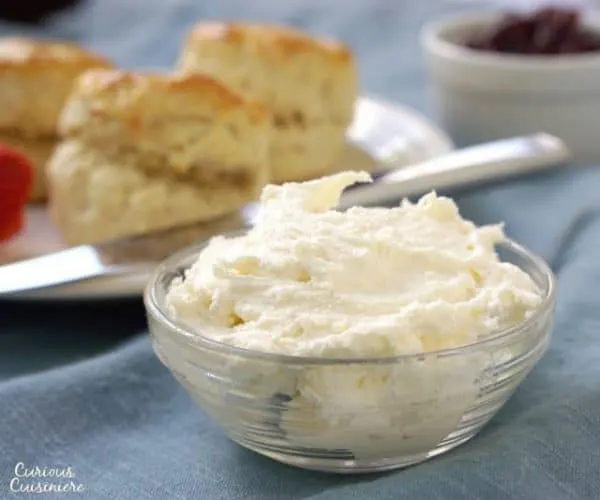
What to do with the leftover whey from making clotted cream?
When you make clotted cream, you will be left with a thin, milky liquid below the clotted cream.
That liquid is basically skim milk, and while we don’t think it has the best flavor for drinking, it is perfectly good for baking.
You can use it in any baking recipe that calls for milk. Our favorite way to use it is to make a batch of British scones.
However, it would also work well to make this Brazilian French toast or this Finnish braided bread.
Can you freeze clotted cream?
Frozen dairy tends to lose its thickness and creamy texture, so we wouldn’t recommend freezing homemade clotted cream. (We’d use it in some of the ways suggested above first.)
That being said, we have heard of some people having luck freezing clotted cream in an airtight container, if it is thawed overnight in the refrigerator before you would like to use it.
If you’d like to try this, we’d suggest starting with a small test batch to see how you like the results.
Buying jars of imported clotted cream can get quite pricey. But you don’t have to worry about that anymore!
Homemade Clotted Cream
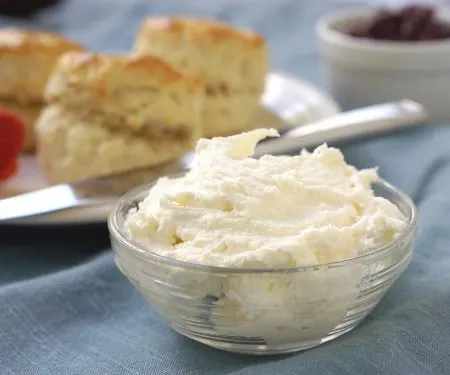
To make clotted cream, you will want to start the process 3 days before you plan to serve your cream. It sounds like a lot of time, but most of the process is done while you sleep!
Ingredients
- 2 c (237 ml) heavy cream, (not ultra-pasteurized)
Instructions
Day 1
- Preheat your oven to 170-180F.
- Pour the cream into a shallow casserole dish or glass baking dish. (The cream should only come up the sides about 1-2 inches. The key here is to have a lot of surface area.)
- Place the cream in the oven for 12 hours, uncovered. (This works great overnight.**)
Day 2
- After heating for 12 hours, the cream will develop a skin. Carefully remove the dish from the oven and let it cool to room temperature. Once cool, cover the dish and refrigerate it for 8 hours (or overnight again).
Day 3
- After chilled, gently skim the thick layer of clotted cream from the surface, leaving the thinner liquid behind. (It will feel like you’re pulling a layer of slightly softened ice cream from the top of a layer of milk*. The skin in fine, it will soften as it is mixed into the cream.)
- Gently stir the skimmed clotted cream to create a smooth texture. (If your cream is too thick for your liking, you can always stir a little bit of the thin liquid back into your cream, until it reaches your desired consistency.)
- Store the clotted cream in a sealed container in the refrigerator for up to two weeks. (Clotted cream can also be frozen and thawed in the refrigerator, if desired.)
Notes
*The leftover liquid can be used like milk. It’s great for baking!
** Oven note #1: Some ovens have a safety feature that shuts them off after extended periods of time. If this is your oven, you may want to do the clotting step during the day, when you can make sure your oven stays on and at a low temperature.
Oven note #2: We have a lot of readers who are discovering as they try this recipe that their oven runs hot. After 12 hours in the oven, their cream has developed a dark brown skin. The skin on your cream should only be a pale tan if it starts to darken. If you think your oven may run hot, check your cream after 8 hours and again after 10 hours to see if the top is darkening. If it is, you may need to cycle your oven between off and on to keep a temperature that is not too hot for the cream. (As a side note, the darkened top on the cream does not mean it is ruined. It simply means your finished cream will have a bit of a deeper flavor, and it will most likely have some flecks of brown and not be a pure creamy white.)
Nutrition Information:
Yield:
16Serving Size:
1 gAmount Per Serving: Calories: 101
If you liked this recipe, here are some similar dishes you may enjoy!

Sarah founded Curious in 2010 as a way to save her recipe creations and share culinary experiences. Her love for cultural cuisines was instilled early by her French Canadian Grandmother. Her experience in the kitchen and in recipe development comes from over 10 years working in professional kitchens. She has traveled extensively and enjoys bringing the flavors of her travels back to create easy-to-make recipes.
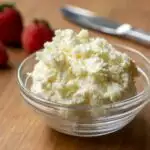


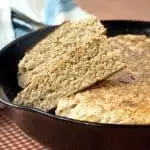


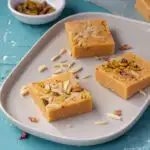

Lanni
Saturday 17th of August 2024
My family makes Cornish Clotted Cream, so I have had the real thing. This one was pretty good. My family has the Queens Warrant to make this cream.
Sarah - Curious Cuisiniere
Thursday 22nd of August 2024
Thank you Lanni!
Daiva
Saturday 13th of July 2024
I was wondering of dehydrator can be used to make it since it can be set to 170-180F?
Sarah - Curious Cuisiniere
Monday 15th of July 2024
Hi Daiva. We haven't tried this process in our dehydrator, but I would think it would work just fine. As long as you can leave your cream in an open-topped container in your dehydrator at 170-180F, it should work well. If you give it a try, let us know how it turns out for you!
maidie
Wednesday 8th of May 2024
Hello Sarah and ? (I don't know his name yet) I found this recipe as my daughter and I will be hosting a mother/daughter tea in the neighborhood, and my daughter asked me to look up some recipes. I found your website, and haven't closed the tab yet! I love that you have the cultural history of the foods, it makes it so much more interesting. I am a periodic cook, but as a child I would read my moms Joy of Cooking. They would give so much information in beginning of each section. I made your clotted cream, and had just heated something so my old Wedgewood oven was still hot. I put the dish in but did not keep any heat on. (It has a huge pilot light and is always warm.) In the morning the cream had risen and clotted, but it was not very golden, but I put it in the basement anyway. Sure enough, it separated out and I had the buttermilk left. We made your biscuits and cream and jam and it was wonderful. The next morning I used the buttermilk to mix in with some oat groats that I had cooked up with some honey. Yum.
Sarah - Curious Cuisiniere
Saturday 11th of May 2024
We're so glad you found us and enjoyed the clotted cream! We hope your mother/daughter tea was a wonderful time! (And Tim is the name of the other half!)
Samantha G.
Thursday 21st of March 2024
Followed this recipe for the first time this week, and OH MY GOODNESS — it is SO tasty and so very easy! I was luckily able to find a non-Ultra Pasteurized cream at a local organic market. I made 32oz at once in a 13"x9" glass baking dish, no problem. Thank you so much for sharing this! Now to try not to make it every week of the year! lol!
Sarah - Curious Cuisiniere
Tuesday 26th of March 2024
We're so glad you enjoyed it!
Dave
Tuesday 30th of January 2024
I'm making this at the moment using 33% whipping cream from my local supermarket. I'm heating it at 80C in a steam-injection oven for 12 hours with the humidity set to 35%.
If it works I'll add a few citric acid crystals to the leftover milk then make some scones to go with it.
Sarah - Curious Cuisiniere
Saturday 3rd of February 2024
We hope you enjoy it!